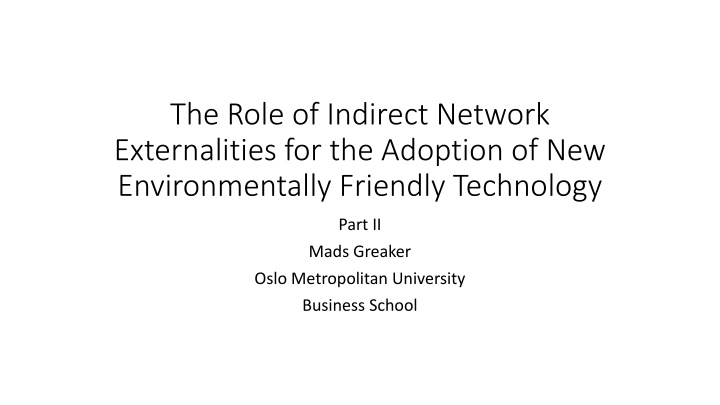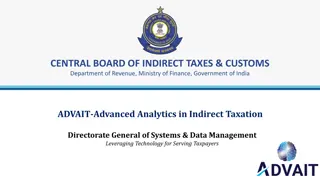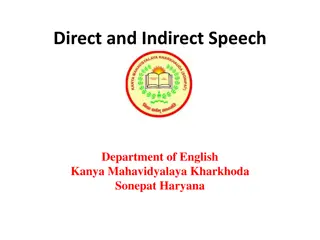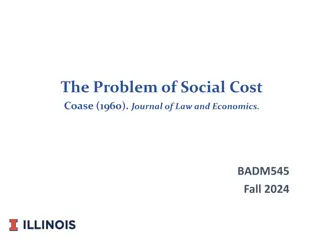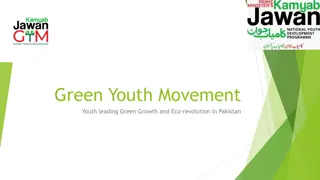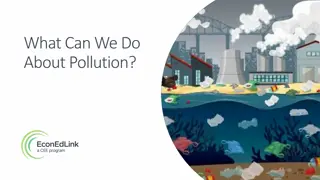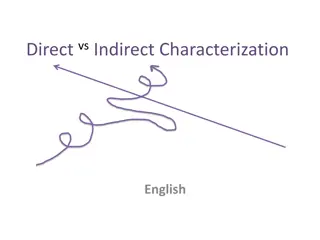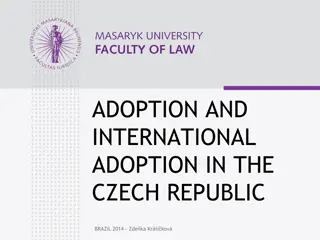Role of Indirect Network Externalities for New Eco-Friendly Technology Adoption
The competition between clean and dirty networks, the impact of network effects and environmental externalities on clean technology adoption, and the importance of setting optimal emission taxes are discussed in this study. The analysis emphasizes the market share of clean goods and highlights the risks of excess inertia in transitioning to eco-friendly technologies.
Download Presentation

Please find below an Image/Link to download the presentation.
The content on the website is provided AS IS for your information and personal use only. It may not be sold, licensed, or shared on other websites without obtaining consent from the author.If you encounter any issues during the download, it is possible that the publisher has removed the file from their server.
You are allowed to download the files provided on this website for personal or commercial use, subject to the condition that they are used lawfully. All files are the property of their respective owners.
The content on the website is provided AS IS for your information and personal use only. It may not be sold, licensed, or shared on other websites without obtaining consent from the author.
E N D
Presentation Transcript
The Role of Indirect Network Externalities for the Adoption of New Environmentally Friendly Technology Part II Mads Greaker Oslo Metropolitan University Business School
Two competing networks History becomes important When two networks starts out simultaneously, small events may lead to a winner and a looser, and the winner may not be the most preferred e.g. Betamax versus VHS for video consoles When a new network challenges an incumbent network, excess inertia is a real treath There are examples of technologies that never maid it e.g. quadrophonic sound Greaker og Midtt mme (2016) looks at the competition between a dirty and a clean network
Network effects and environmental externalities: Do clean technologies suffer from excess inertia? Journal of Public Economics (2016) 3
What we show: Even with constant marginal environmental damage the emission tax should depend on the market share of the clean good during the transition phase The optimal emission tax can be decomposed into; Marginal environmental damage External marginal network benefits Interaction term Failure to set the optimal tax may lead to excess inertia
Point of departure; Literature General: Farrell and Saloner, AER, 1986 Ochs and Park, JET, 2010 Katz and Shapiro, J. Pol. Ec., 1986 Liebowitz and Margolis, J. Ec. Perspec., 1994 Cabral, Rev. Ec. Stud., 2011 Environmental and resource economics Sartzetakis and Tsigaris, J. Reg. Ec., 2005 Conrad, Ger. E. Review, 2006 Greaker and Heggedahl, BEJEAP, 2010
The model Dynamic model with a government that set taxes, firms that set prices and consumers that make choices in an infinite number of periods One clean and one dirty technology (durable) Clean is less costly IF the environmental externality is factored in In each period a fraction of the durables wears out, and must be replaced Utility from the clean durable depends on the number of clean consumers, and likewise for the dirty durable Technologies are imperfect substitutes There is a given number of consumers, the market is fully covered, and per period use is given
Consumers The choice problem: Pay-offs: Development in market shares:
Demand functions The marginal consumer: Derivation of demand: Choose dirty; , choose clean;
Producers Maximize firm value with respect to price: First order condition: With many firms offering the same technology:
The government Set dirty good tax to maximize welfare: This amounts to choosing: In steady state we have: Choose dirty; , choose clean; ( )
The optimal dirty good tax tax: The optimal tax has three (four) components reflecting: I. The environmental damage from the dirty good II. The gain(loss) of network benefits from the dirty good III. The interaction beween the environmental damage and the network benefit IV. (The pricing of the technology sponsors)
The network interaction effect: Both the steady state market share of the clean durable, and the time it takes to reach the steady state will depend on the environmental damage from the dirty good Hence we have a network interaction effect:
Oslo, Akershus Castle, 2015 (New York Times, Monday Oct. 19)
Numerical illustration Per 2014, >20.000 EVs in Norway (1% of car fleet), 8% of sales (increasing - Oslo area: 35%!) Electric vehicle (EV) case in Norway: No VAT and no other purchase taxes on EVs In addition to VAT and purchase taxes, gasoline and diesel cars pay high taxes on fuel (CO2, road use, local pollution etc.) In addition EVs enjoy free toll roads, free driving in bus lanes At time of purchase, measured in current value implicit subsidy to EVs = $20.000 (pr. car) But Norway has ambitious GHG emission reduction goals For the non-EU ETS sectors, the goals imply $533/tonn CO2 -> at time of purchase fossil car $ 10.000
Calibration Assume: Equal costs (not the case now but will be soon?), no sponsors Assume functional forms for the after market benefit functions, and set parameters such that the historical development can be replicated (given the implicit subsidy of today)
Policy challenges David (1987) Narrow policy window; In the early stages of competition between emerging networks, policy can have big impacts at low cost Blind giant s Quandry; However, it is very hard to know what technology to prefer Technological orphans; The loosing technology(ies) will have fierce supporters that continue to lobby governments and large resources may be wasted Easier when a clean network competes with a dirty? (You should have zero emissions in 2050 anyway)
Promoting the sales of EVs; the Promoting the sales of EVs; the role of charging standards, role of charging standards, charging infrastructure subsidies charging infrastructure subsidies and direct EV subsidies and direct EV subsidies Mads Greaker OsloMet University & Statistics Norway Forthcoming working paper Vatt seminar 19
Climate change mitigation and EVs IEA (2017): EV stock between 40 and 70 million by 2025 (2 million today) Crucial for reaching the 20C target Rapid market diffusion depends on Further progress in battery technology Building of infrastructure EU (2014) directive on the deployment of alternative fuels infrastructure 20
Research questions: With indirect network effects, should you only subsidize the charging network, only the EV or both the network and the EV? How do charging network compatibility affect the optimal use of subsidies? 21
What I show: More compatibility increases welfare, increases sales and makes it less costly to reach emission targets for the transport sector Subsidies should be used also in the long run equilibrium if the network benefit is linear Both the charging network and the EV should be subsidized
Literature General: Katz, M., & Shapiro, C. (1985). Network Externalities, Competition, and Compatibility. American Economic Review 75: 424-440. Chou C. & O. Shy, (1990), Network effects without network externalities, Int. J. of Ind. Org. 8: 259-270. On EV charging: Zhang, Y., Qian, Z., Sprei, F., og Li, B. (2016). The Impact of Car Specializations, Prices and Incentives for Battery Electric Vehicles in Norway: Choices of Heterogeneous Consumers. Transportation Research Part C: Emerging Technologies , 69: 386-401. Li J. (2016), Compatibility and Investment in the U.S. Electric Vehicle Market, Job market paper, Harvard University. Li S., L. Tiong, J. Xing and Y. Zhou (2017): The market for Electric Vehicles: Indirect Network Effects and Policy Design, J. of the Association of Environmental and Resource Economists This paper: First theoretical model of different standards with indirect network externalities First paper to look at optimal subsidies Calibrates the model to the Norwegian case 23
The model Consumers choose between a generic gasoline car and N types of EVs EVs only differ wrt. to their charging network There is Cournot competition between the N types of EV The charging network consists of separate charging station owners Each charging station is differentiated on location (and type) from the others There is monopolistic competition between charging station owners of the same type We look for a long run fulfilled expectation Nash equilibrium 24
The reduced form utility function I use the monopolistic competition model for charging station entry and supply In addition I assume 1 = I then get: Note that network utility parameter is decreasing in the fixed cost of charging stations and the price of charging, but increasing in ? & ? 25
Compatibility = y x No compatibility: Each type can only use its own system: i i n = y x Full compatibility: All chargers are available to all types: i i = 1 i m = m n , y x Partial compatibility: Some brands share network: i i = 1 i Increased compatibility = Increased utility of EVs 26
Demand for EVs Marginal cost of a gasoline (diesel) car is normalized to zero There is a subsidy s for EVs, and production costs are c > 0 A consumer chooses an EV if: EV buyers then equal: Demand for EVs can then be expressed 27
Supply of EVs Cournot game with n EV producers that maximize: ? ?? ?)?? max (? + ? + ? ?? ?as given The producers take ? ?? Depending on the expectations (and the parameters), there may be multiple equilibriums We concentrate on the fulfilled expectations equilibrium, and assume a unique equilibrium 28
Market equilibrium Let there be ? symmetric networks Due to our assumption about linearity of network benefits, we can solve the model explicitly: Equilibrium output is decreasing in the number of networks, and increasing in the EV subsidy and the fixed cost subsidy (since ? ) Note that we must have ? < 1 in order to have a unique equilibrium 29
Welfare Welfare consist of consumer surplus and EV producer surplus subtracted the subsidy costs (Producer surplus in the charging market is zero) Consumer surplus Welfare:
Optimal policies Higher degree of compatibility always increases welfare Even when the number of EV firms approaches infinity such that Cournot competition yields the competitive outcome, we have: Where ? & > 0 The charging station subsidy depends only on the low of variety parameter The EV subsidy is larger than the environmental benefit from EVs, and increases in A Moreover, it increase in the low of variety parameter, and decreases in the degree of compatibility (can be shown) 31
Market share target Many countries have a marketshare target for EVs: Finding the optimal subsidies is then equivalent to minimizing the fiscal costs of the government: EV subsidies should only be used if the charging station subsidy is not sufficient to reach the target 32
Numerical simulation The effect of compatibility in long run equilibrium: Point of departure: Long run equilibrium in 2030 with 40% EVs in car stock without subsidies and four incompatible networks We do not know kappa ; the value of the network in the utility function kappa will determine the elasticity of demand with respect to the size of the network 33
Market share target Optimal policies: 34
Private incentives for compatibility? Full compatibility is best for social welfare (in our static model) Compatibility profitable for symmetric firms, but not necessarily for asymmetric Farrell og Simcoe (2011) three ways to compatibility: i) Coasian standard setting institutions ii) Through adapters iii) Government legislation Both i) and iii) can reduce incentives for innovation Innovation is happening: VW/Audi talk about 300 kW, or cable free charging 35
